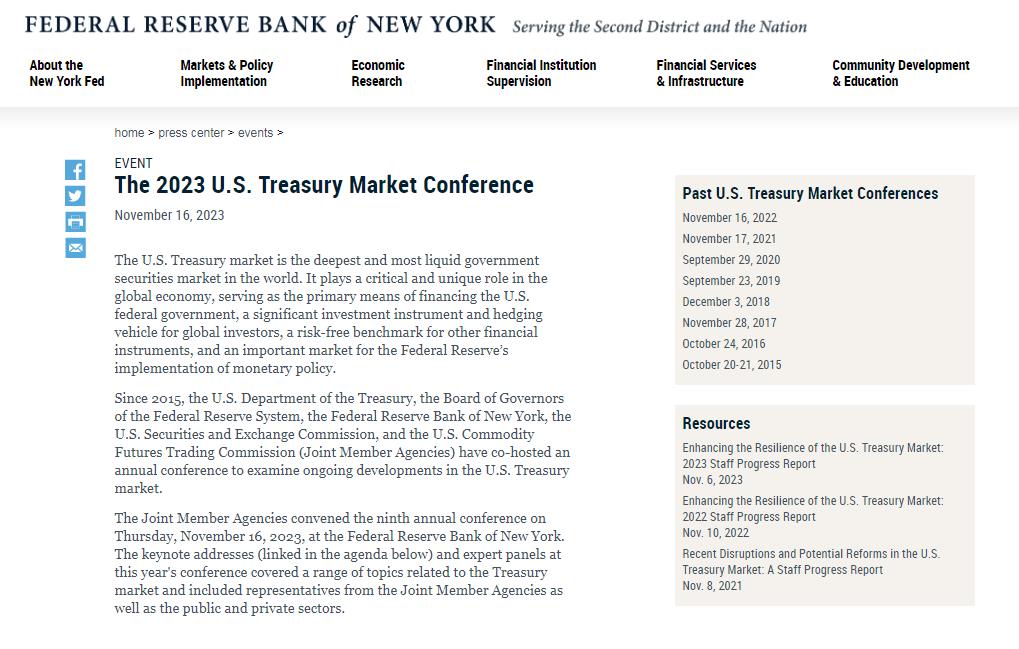by Chris Black

The Fed’s recent Treasury market conference (https://www.newyorkfed.org/newsevents/events/markets/2023/1116-2023) offered three notable insights that suggest Treasury market liquidity will continue its structural decline:
First, dealer balance sheet constraints have moved from ones that could be solved through central clearing to those that would require other adjustments.
Secondly, mandatory Treasury repo clearing may reduce market liquidity by raising the cost of financing due to higher collateral haircuts. Lastly, mutual funds may not become significant marginal investors in cash Treasuries as regulations encourage them to invest using Treasury futures.
This post discusses each point and suggests that Treasury market liquidity will continue to deteriorate .
The binding balance sheet constraints (https://www.newyorkfed.org/research/staff_reports/sr1070) on the activity of securities dealers today appear to be moving to those that would not be solved by central clearing.
A binding constraint (https://www.bis.org/publ/work666.pdf) limits the extent to which a unit can expand, thus affecting the profits that a marginal increment of capital generates.
The image above shows how cleared repo reduces net balance sheet size, but not gross. Some regulations look at net balance sheet size, but others look at gross size.
Recall, the scale of dealers’ activity in markets is constrained by costs imposed by a number of rules (https://www.newyorkfed.org/research/staff_reports/sr1070) that are each calculated differently. Market participants have often pointed to the supplemental leverage ratio (https://www.ft.com/content/e40412fc-590c-4a6d-bed9-a61d6c03feba) (SLR) as discouraging Treasury market activity because it imposes costs in proportion to the net size of a balance sheet without regard to asset quality.
Dealers have been optimizing against this constraint through central clearing (https://www.jpmorgan.com/insights/markets/fixed-income/sponsored-repo), which allows them to net down trades and thus reduce the size of their balance sheet under the rules.
In short, “netting (https://www.eurex.com/resource/blob/2602520/8747aa5743eea41f02aa1871025e3ede/data/balance-sheet-netting.pdf)” incentivizes Treasury repo activity, which creates demand for Treasuries.
But it now appears that their binding constraint has moved to regulations that are instead applied on a gross basis, such as the GSIB Short-Term Wholesale Funding (https://www.law.cornell.edu/cfr/text/12/217.406) score.
This suggests that the official sector’s push towards cleared repo may not improve dealer capacity.
Note that the proposed Basel III endgame rules are also expected to further raise dealer costs (https://www.federalreserve.gov/newsevents/pressreleases/waller-statement-20230727.htm) and potentially reduce their market making activity in the Treasury market.
The SEC’s proposal for mandatory repo clearing (https://www.sec.gov/news/press-release/2022-162) may reduce Treasury market liquidity by raising the cost of repo financing.
Recall that hedge funds can purchase a security, simultaneously enter into a repo agreement to borrow against that security, and then pay for the initial purchase of the security using proceeds from the repo loan.
For example, a hedge fund who wants to invest $100 in Treasuries can put down $1 of its own money and end up borrowing the remaining $99 in a repo transaction. This is repo financing.
Hedge funds cannot sell $100 in Treasuries for the full $100 because the dealer will ask for a small haircut to protect itself from any changes in the collateral value. The haircut may be 1%, so the hedge fund sells $100 in Treasuries for $99 to the dealer.
The repo market is comprised of different segments and a sizable volume (https://www.financialresearch.gov/briefs/files/OFRBrief_23-01_Why-Is-So-Much-Repo-Not-Centrally-Cleared.pdf) of transactions are within the uncleared bilateral segment , which is largely comprised of trading between hedge funds and dealers. One notable aspect of the uncleared bilateral repo segment is that haircuts are around 0% (https://www.financialresearch.gov/briefs/files/OFRBrief_23-01_Why-Is-So-Much-Repo-Not-Centrally-Cleared.pdf).
In contrast to dealers, clearinghouses will demand some amount of margin (money up front) depending on the characteristics of the trade. This means that mandatory repo clearing will essentially impose large market wide haircuts and increase the cost of repo financing.
A recent Fed study (https://www.federalreserve.gov/econres/notes/feds-notes/hedge-fund-treasury-exposures-repo-and-margining-20230908.html) suggests that 2% haircuts would double the capital hedge funds need in their relative value trades and thus require a doubling of spreads to maintain the same level of return.
A more likely result may be for them to scale back activity — leaving the cash Treasury market with even less liquidity.
Mutual funds may not increase investments in cash Treasuries because they prefer Treasury exposure via derivatives rather than cash.
Mutual funds could increase cash Treasuries holdings using repo financing, but repo loans were historically counted (https://www.sec.gov/divisions/investment/imseniorsecurities/ic-10666.pdf) in mutual fund leverage limits with loan interest flowing through their expense ratio.
In contrast, mutual funds could gain comparable exposure using Treasury futures with fewer limitations.
The two positions are functionally equivalent, but think of repo loans as “on balance sheet” while futures are “off balance sheet.”
The difference in regulatory treatment encouraged mutual funds to express Treasury exposure through futures. The SEC has recently updated regulations (https://www.sec.gov/files/rules/final/2020/ic-34084.pdf) on leveraged positions, but mutual funds appear to continue to prefer Treasury exposure through futures.
Treasury futures positions of asset managers have surged since mid-2022, so mutual funds (or any real money investor) will likely not become a significant marginal buyer of cash Treasuries.
The official sector appears to be making adjustments that will make it more difficult for the market to absorb the upcoming deluge of Treasury issuance.
At a high level, cash Treasuries can be held by investors using borrowed money or cash investors. The leveraged investors are more nimble participants as cash investor participation depends on asset inflows or the liquidation of other asset holdings.
Going forward it looks like the costs of leveraged financing will increase due to mandatory cleared repo and a limited supply of repo financing that remains constrained by regulatory costs.
Major investors that could participate in the cash market remain incentivized to instead use Treasury futures.
The structural trend of a Treasury market that is less liquid and more volatile looks to continue.